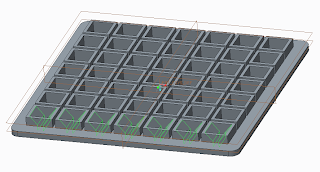 The outer former has been assembled. I've used right angle metal bracket to secure the former down to the sheet of mdf.
The outer former has been assembled. I've used right angle metal bracket to secure the former down to the sheet of mdf.You can see the 3d printed feature housed in the walls of the former.
The silicone cast features have been glued in position. In hindsight I'd have perhaps liked these to not be permanently fixed.

The inner core has been screwed in place. The outer walls of the core will remain insitu. The blue foam is a precautionary measure in case the acrylic/glue joint fail.
I've decided to use latex cement. The walls of the speaker in some places are less than 10mm thick and the features are incredibly intricate. This would cause significant problems when using conventional concrete. Latex cement is used typically for self levelling floors. The mix is very wet, and so should run freely in to the mould, preventing any honeycombing to the finished surface. Traditionally mould oil or release agent is applied to the surface of the mould to prevent it from adhering to the concrete. However, because this is only bought by the gallon, I've decided to try traditional motor oil.
When pouring the concrete I took great care to pour in layers. Unfortunately, I didn't have access to a vibrating plate or rod to reduce the risk of trapped air. However, I did tamp the concrete and gently tap the sides of the mould.
As seen on the picture to the right, some concrete did flow beneath the mould. I didn't anticipate this, for the next pour I'll silicon seal the joint to prevent loss of material.
The self levelling concrete requires no floating to finish. It takes 2-4 hours to set. However, I'll leave it 12 hours. This should be sufficient time for the concrete to harden. Concrete can cure for 28+ days, but, if left in the mould this long, the potential for the concrete to adhere to the mould increases and so the risk of damage during removal.

















